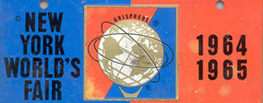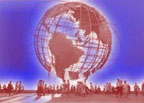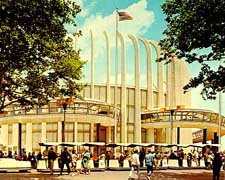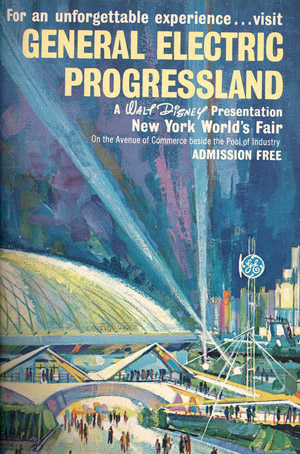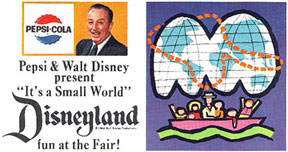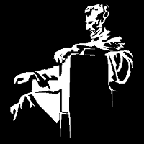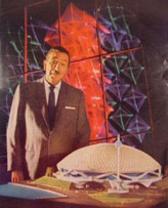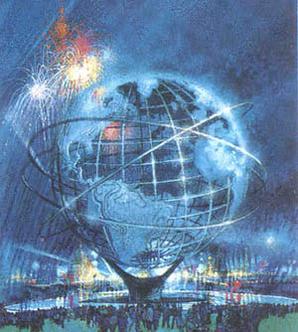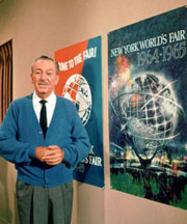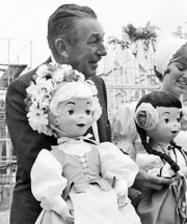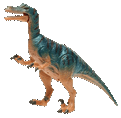These 4 attractions (which all used Audio-Animatronics) were among the most popular and most visited at the fair. Robert Moses, the president of the New York World's Fair, asked Walt Disney to takeover the fairgrounds after 1965 and turn it into some sort of East coast Disneyland. Walt passed on the idea of a park in New York, but he did take these World's Fair attractions to his Anaheim, California park. Disney's It's a Small World was transferred to Disneyland, as was the Carousel of Progress. A second Abraham Lincoln animatronics figure became the centerpiece of the Great Moments With Mr. Lincoln show. Scenes from the Ford Magic Skyway were used in Disneyland Railroad's Primeval World Diorama and the ride system was improved upon and used for the PeopleMover.
 | ||||||
For more information on the 1964-1965 World's Fair,
This Day in Disney History highly recommends
"This is Walt Disney speaking. Our Space City is a distant dream. But all such dreams must begin in the minds of men. Men like the scientists, engineers and automotive designers of Ford Motor Company. I hope you enjoyed our show and your ride on The Magic Skyway in
a new Ford product as much as I've enjoyed the Fords I have driven through the years. Now step out and see a world where tomorrow is being created today."
The fair at the Flushing Meadows Park in Queens, New York was
days. (This World's Fair took place without sanctioning from the
Bureau of International Expositions, the only one to ever do so.) The largest
World's Fair to be held in the United States, gates opened at 9 a.m. everyday
including Sundays and holidays.
The Ford Rotunda, a building several blocks long featured a number of exhibits which
emphasized automobiles. Fairgoers, seated in one of 160 1964 Ford convertibles, could
tune the radio to any of 4 languages and hear the fascinating story of man's progress
through the ages. Riding the "Magic Skyway," guests first were taken through plastic
tunnels around the outside of the rotunda for a sweeping view of the grounds, then
onto the exhibit building and the fantasy-land within. With a narration by Walt Disney
himself, guests toured the earth's past from the dawn of time, through the age of
dinosaurs (munching on vegetation), to the world of the caveman. The dinosaur
portionof the "Magic Skyway" would later be moved to Disneyland. As guests left the
cavemen, they entered a Space City filled with futuristic wonder. (Enough steel went
into the construction of the Ford Rotunda to erect a 22 stories high skyscraper!)
General Electric's Pavilion, under a huge flattened dome
suspended from spiral pipes, presented "Progressland" depicting
the history of electricity from its beginnings to the mighty bang
of nuclear fusion. Its multi-part show used a unique theater.
Separate auditoriums, each holding 250 people, circled the
various stages set in the middle, and stopped to watch life-
sized 3-D Audio-Animatronic people act out the story of
electricity in the home from the 1890's to the present.
The show featured a catchy little tune called "There's a Great
Big Beautiful Tomorrow," written by Richard M. Sherman and
Robert B. Sherman.
(After the Fair, the attraction was moved to Disneyland and
named The Carousel of Progress. Years later it was
relocated to Walt Disney World.)
Pepsi's Pavilion brought a small scale Disneyland to minute boat ride
called "It's a Small World - A Salute to UNICEF" carried spectators past
familiar miniature scenes as France's Eiffel Tower, a Dutch windmill and
India's Taj Mahal. The animated children, animals and birds sang and
danced to the Sherman Brothers' theme song called "It's a Small World."
During the Fair's first season, the ride cost 95 cents for adults and 60
cents for children (but admission into the pavilion was free).
The highlight of the Illinois Pavilion in a 496-seat theater was a life-sized
Audio-Animatronic figure of Abraham Lincoln. "Great Moments with Mr. Lincoln"
(which officially opened on May 2, 1964) included excerpts from Lincoln's speeches on
liberty, civil rights and freedom. The figure (voiced by actor Royal Dano) was capable
of more than 250,000 combinations of action, including smiles, frowns, and gestures.
Such legendary Disney veterans as Roger Broggie and Eustace Lycett were responsible
for this amazing electronic man. The Illinois Pavilion (the only all brick structure on
the fairgrounds) was the only pavilion of the four at the Fair featuring Walt Disney
developed attractions, that was not designed by Disney Enterprises.
 | ||||
 | ||||
 | ||||
 | ||||
DISNEY AND THE NEW YORK WORLD'S FAIR - THE FIRST GOLDEN ERA OF IMAGINEERING
“When we completed 'It’s a Small World' for presentation at the New York World’s Fair, we felt that we had accomplished what we’d set out to do. We wanted to foster a better understanding among the nations of the world by showing the dress, the customs, the language, the music, and a little of the culture of our neighbors around the world - - and we wanted to show it to be a very happy one. And I think it’s safe to say that having fun has universal appeal.” -Walt Disney
DID YOU KNOW ...
To mark the fair's closing in October 1965, Westinghouse Corporation assembled a time capsule and buried it below Flushing Meadows. It is to be opened in the 70th century!
DID YOU KNOW ...
The Unisphere, the symbol of the 1964/1965
World's Fair, still stands today. It is a 12 story
high stainless steel model of the earth designed
and fabricated by the U.S. Steel Corporation.
 | ||||
THIS DAY MADE
IN THE
USA
In 1963, Disney Imagineer & future
Disney Legend Don Edgren went to
New York for a year as a project
engineer on Ford Motor Company's
exhibit at the 1964 World's Fair.
Paul Frees (future Haunted Mansion Ghost Host) narrated the preshow to Great Moments! His World's Fair
vocal talents could also be heard in Disney's Progressland and the non-Disney Hall Of Science "Rendezvous
In Space" movie, and the "Les Poupees des Paris" puppet show.
MAGIC SKYWAY
PROGRESSLAND
IT'S A SMALL WORLD
GREAT MOMENTS
DISNEY & THE
1964-65 NEW YORK
WORLD'S FAIR
Back in 1958, Walt Disney and General Electric had an idea for a Disneyland
area to be called Edison Square - a residential extension of Main Street. Edison Square even appeared on Disneyland maps as a "coming attraction." But by
1959 G.E. requested that the idea instead be altered and used for their pavilion
at the 1964 World's Fair.
Upon completion of the show, guests
went upstairs to view Progress City -
Walt Disney's 160-foot scale model for
EPCOT. Admission was free and each
show lasted 45 minutes.
"We are now animating human
beings ... but we have no intention
of replacing them." -Walt Disney
Walt Disney always had an affection for America's past. As early as 1956, an idea for a new Disneyland attraction
devoted to America's principles was already in the works. The attraction, One Nation Under God with a finale
called Hall of Presidents was to be located off Town Square on Main Street. The show's most important feature
would be an electronic President Abraham Lincoln. In 1962, World's Fair President Robert Moses was shown a
Hall of Presidents mock-up. He was so thrilled that he wouldn't "open the Fair without that exhibit!" By July 1963,
Moses had convinced the State of Illinois to feature Disney's Lincoln at their Fair pavilion.
During the Fair's 2nd
season, another Great Moments with Mr. Lincoln
opened at Disneyland in
the Main Street
Opera House.
Pepsi-Cola first approached Disney in mid-1963 with an idea to create a World's Fair exhibit which would salute and benefit UNICEF
(The United Nations Children's Fund). Pepsi's reason for contacting Disney so late in the game? They couldn't find a designer to create
their "happiest cruise that ever sailed" and debated over actually cancelling the idea. Just 10 months before the fair's opening, actress
Joan Crawford (who was on the board of directors for Pepsi) strongly suggested they contact Disney. At first Disney actually declined
due to their already heavy World's Fair workload. However, Walt himself eventually accepted the challenge (much to the surprise of
his Imagineers) to build "a little boat ride."
Helping in the design and construction of
It's a Small World was illustrator Mary Blair
(one of Walt's favorite artists), Alice Davis
(wife of Marc Davis - one of Walt's Nine Old
Men), and painter & Imagineer Claude
Coats. Blair's vibrant graphics, Davis'
costuming, and Coats' overall layout helped
to create an attraction that is
still loved today.
"Welcome aboard Ford Motor Company's Magic Skyway - an adventure created by the incomparable Walt Disney. A
voyage through time and space from a dark and distant yesterday to a bright and promising tomorrow. I hope
you will all have an entertaining trip, and now here to tell you about your journey - is Walt Disney." -Henry Ford II
Disney's work for the 1964-1965 World's Fair continues to fascinate fans of both Disney and World's Fairs. Maybe it's the influence on today's theme parks - from a simpler time when anything seemed possible - that draws us back to these 4 special groundbreaking attractions.
In March 2009 Walt Disney and the 1964 World’s Fair, a 5-disc audio package featuring a 24-page color booklet, was released on Walt Disney Records.
"I’m interested in doing things of lasting value. It’s heartbreaking to tear them down after two years."
-Walt Disney July 1965 TV Guide article
"The World's Fair was critical, because Walt (Disney) used it as a proving grounds for WDI to develop bigger and better shows, and to advance animatronics beyond the (Enchanted)] Tiki Room. I consider the fair to be the first golden era of Imagineering attractions. The Omnimover system, the PeopleMover, and sophisticated audio-animatronics were all developed for the fair. It was a giant leap forward in what could be done." -Imagineer Tony Baxter
FIRST GOLDEN ERA OF IMAGINEERING
Above the pavilion was the 120-foot Tower of the Four Winds, a fanciful creation of 50-plus
colored shapes that danced and twisted in the wind. The large kinetic sculpture was designed by
Rolly Crump and became a World's Fair icon. Unfortunately when it came time to move Its a Small
World to Disneyland, the expense of moving The Tower of the Four Winds proved to be prohibitive.
"The World’s Fair was really a big lesson, a big proving ground in many ways for us. The main thing that we learned from the World’s Fair was that the audience was there for Disney-style entertainment. Out of the five most-visited shows, we had four of them." -Disney Legend Mart Sklar
Interesting to note - the Ford Mustang was first
introduced to the public at the New York World's
Fair on April 17, 1964, and via all three American
television networks on April 19. It wound up
being one of the most successful product launches
in automotive history.
The fair, which stood on the grounds of the 1939-40 New York World's Fair, featured
140 pavilions on 646 acres (occupying nearly a square mile of land). Among the many
attractions and pavilions were 4 designed by The Walt Disney Company:
Imagineer Bob Gurr designed the mechanics for the Mr. Lincoln figure & veteran James Algar wrote and produced the show.
It's a Small World stands alone as the last true survivor intact from the 1964 World's Fair. Although the Carousel of Progress and Great Moments With Mr. Lincoln exist, they are so far removed from what they represented at the Fair that most wouldn't describe them as true World's Fair legacies.
1964/1965 World's Fair
This Day in Disney History - THE FIRST - THE ORIGINAL
Traveling in time since 1999!
